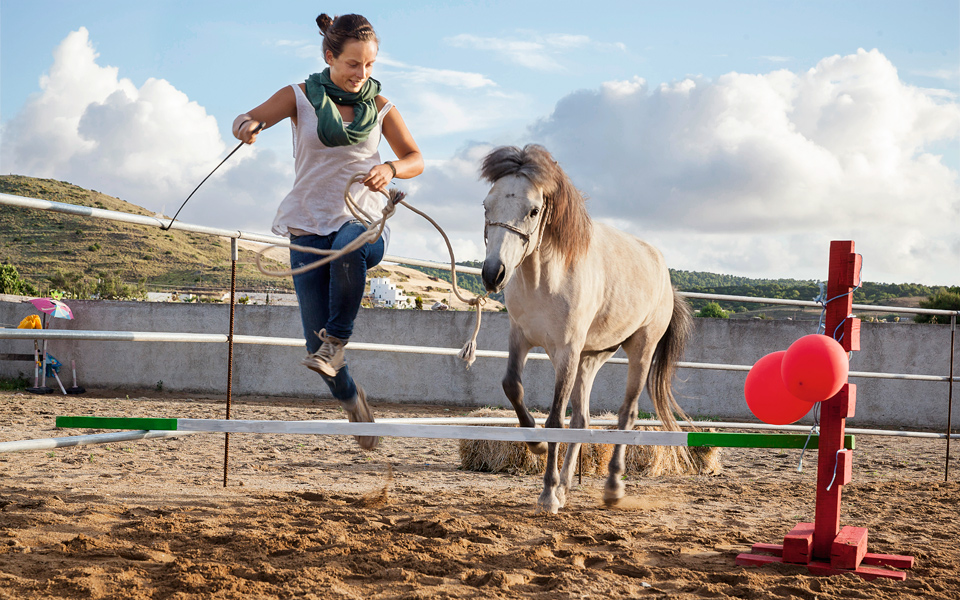Ever since her first visit to Greece, while still a student in the UK, Amanda Simpson fell in love with the country, vowing – and succeeding – to visit every summer. Although enchanted by the islands of the Cyclades and Lesvos, she instantly felt a special affinity with Skyros in the Sporades island cluster on her first visit there. “It was like returning home after a long absence. I started thinking what it would be like to live here permanently. My intuition kept telling me that this place has something special to offer and I decided to follow this feeling,” she recalls.
Her intuition proved correct. While in Skyros, Amanda met her soul mate, Stathis Katsarelias, as well as the equus ferus caballus, a breed of short-bodied ponies native to Greece. The couple has dedicated their lives to the care, controlled breeding and promotion of the ponies.
Simpson, who grew up in a small village in Norfolk, was already well versed in horse care. “I rode ever since I was 2 years old, even before I could walk properly. But I must admit, Skyrian ponies are the best horses I’ve experienced: mild tempered, compassionate, intelligent and playful at the same time. In one word: interesting!”
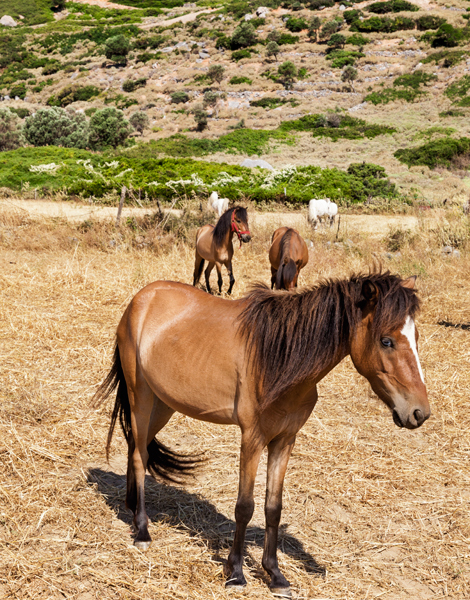
© Leonidas Kouris
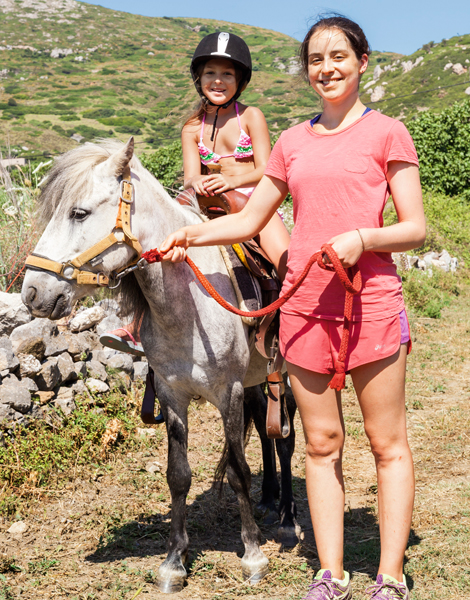
© Leonidas Kouris
In 2003, when Simpson and Katsarelias set up their farm in Trachy, they had but one horse. Today they have 40, with names taken from Greek mythology: Jason, Zeus, Orpheus, Icarus and Nephele, among many others. The only exception is a pony named Norman after Amanda Simpson’s father, who passed away two days before the beautiful male pony’s birth.
Everyday life is no picnic. Work begins at daybreak and ends well past sundown. The ponies must be fed and groomed and the stables cleaned, while the extended “family” also consists of 13 cats, two dogs, two goats and a great number of chickens.
“Horses are like children. They need stability. Change is unsettling to them,” says Simpson. During the summer months, the couple hosts courses for the benefit of visitors. They work mainly with children, teaching them to ride but also to communicate with horses, while learning constantly themselves, thanks to their daily contact with the ponies.
“Time spent with them is time gained. They understand you, they can see through you, they are a mirror: if you are happy, so are they,” explains the couple.
“Horses are like children. They need stability. Change is unsettling to them,” says Amanda Simpson.
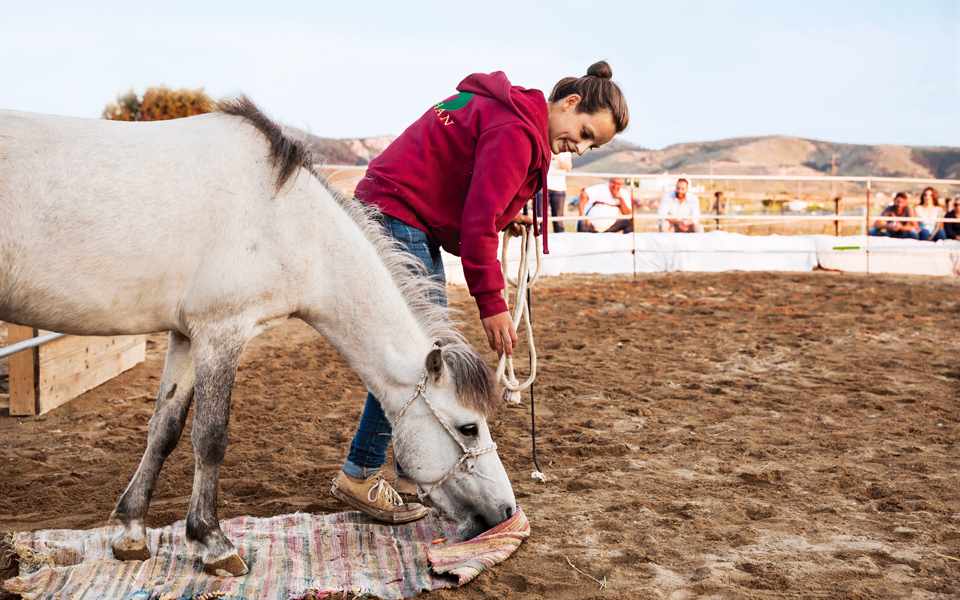
© Leonidas Kouris
FROM THE PARTHENON TO SCOTLAND
Visitors to Skyros will be smitten by the beauty of its beaches, the richness of its folk art and its gastronomic variety. But few are aware that its diminutive ponies are the ones gracing the Parthenon’s frieze as horses drawing carriages in the Panathenaic Procession. Even fewer know that the ponies’ ancestors sailed from the island’s eastern shores bound for Troy, where they would carry Achilles’ warriors on their backs.
Skyrian ponies are usually brown or reddish and do not exceed 116 cm in height. Their hoofs are hard – so they don’t need to be shoed – their mane is long and rich, their legs strong and sinewy, and their bellies slightly distended, as though after a big meal. Seeing them up close, they remind more of Arabian horses than ponies.
“The breed once thrived all over Greece, before disappearing. Only a small number of individuals survive in Skyros today,” says Nikos Kritikos, head of the local Skyrian Horse Society, founded in 2006 to protect the breed and compile its genealogy. The society’s census has recorded 297 ponies, 182 of which live on Skyros. A small number are cared for at the Agricultural University’s farm in Thessaloniki, the Silvaland Riding Center in Corfu, the Amfikaia Farm on Mount Parnassos and in Scotland.
“Skyrian ponies are an endangered species as any animal numbering less than 1,000 individuals is considered to be under threat,” explains Kritikos. Apart from Simpson and Katsarelias, the difficult task of conserving the breed is carried out by the team of Mouries Farm, run by Manolis Trachanas, thanks to their controlled breeding program, while a handful of ponies continue to roam free on Kochylas Mountain.
Greece’s dire financial situation has presented new unexpected obstacles in the two teams’ conservation efforts. The lack of funds has meant a decline in the breeding rate. State subsidies have stopped since 2002, while the yearly upkeep of every single pony in feed alone stands at 700 euros. Some locals have released their ponies into the wild, being unable to care for them, knowing that Kochylas Mountain doesn’t provide a safe haven or a conducing environment to breeding.
The mountain’s flora has been ravaged by goats, while Kochylas is also home to a population of mules known to be aggressive towards male Skyrian ponies. Inbreeding also threatens the species’ uniqueness.
The Skyrian Horse Society is doing its best, having compiled an exhaustive list of all individuals falling within pedigree parameters, photographing them and equipping them with electronic tracking devices. At the same time, Athens Agronomical University laboratories are carrying out genetic tests, using hair from the ponies’ tails or manes. A team of university veterinarians visits the island periodically as Skyros lacks a permanent vet.
“The breed once thrived all over Greece, before disappearing. Only a small number of individuals survive in Skyros today,” says Nikos Kritikos, head of the local Skyrian Horse Society, founded in 2006 to protect the breed and compile its genealogy.
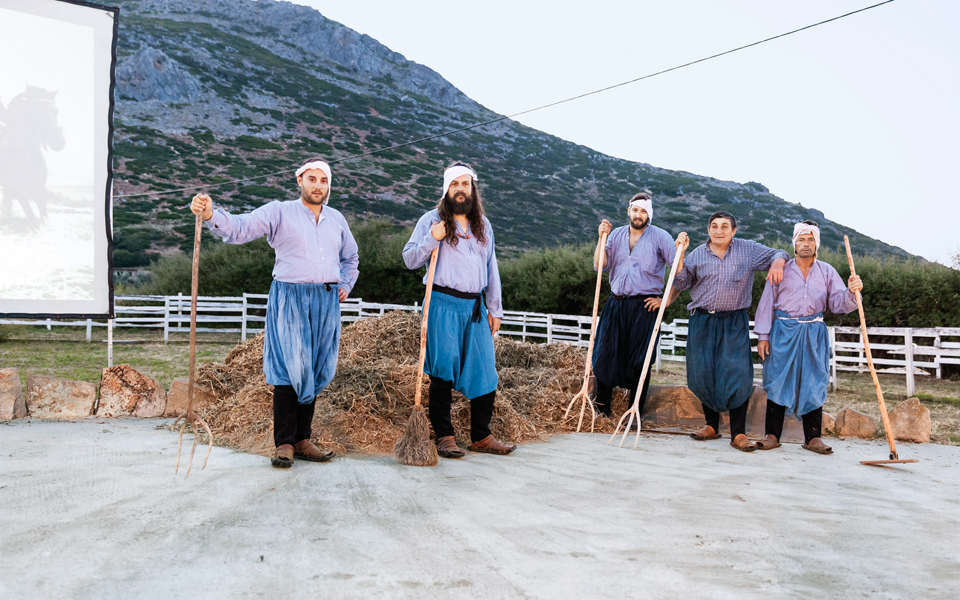
© Leonidas Kouris
IS THERE ANY FUTURE TO EQUESTRIAN TOURISM?
Many locals in Skyros believe that there is. “Our ponies have a way of repaying us for all the trouble we take. They advertise the island all over the world and bring in tourists. This is something everyone should understand,” says Katsarelias. “Hundreds of volunteers from around the world, from Denmark to Germany and even from New Zealand, come to the island every year to help out. We ought to visualize what kind of future we want for our Skyrian ponies. We are talking about an especially intelligent species, obedient, friendly with people and children, making them ideal companions for equine-assisted therapy. We have a duty to attract the world’s attention in order to ensure the Skyrian ponies’ breeding and continued care,” adds Simpson.
One of the best ideas heard lately is the creation of a natural reserve on Kochylas Mountain. There, in an enclosed and guarded area, the ponies could roam free and breed without human intervention, albeit under the Skyrian Horse Society’s supervision. Such an equine park could be open to visitors for a moderate fee. Such an ambitious plan presupposes the approval, disbursement and use of generous European funds, the absence of goats, the planting of hay for feeding purposes and the active involvement of locals. For the time being, the farms and the Society offer “adoption” programs for ponies, as well as suggesting ways to contribute financially to their work.
Kritikos attempts to give a different perspective: “In my opinion, keeping all the ponies on the island would be a mistake. Think of the consequences of a viral infection. We would lose the entire population. Some studs should be exported, as a precaution, as well as any mares we wouldn’t need for breeding.”
Skyrian ponies have survived for centuries, weathering war, famine and natural disasters. The people of Skyros hope that the financial downturn will not spell the species’ end.

